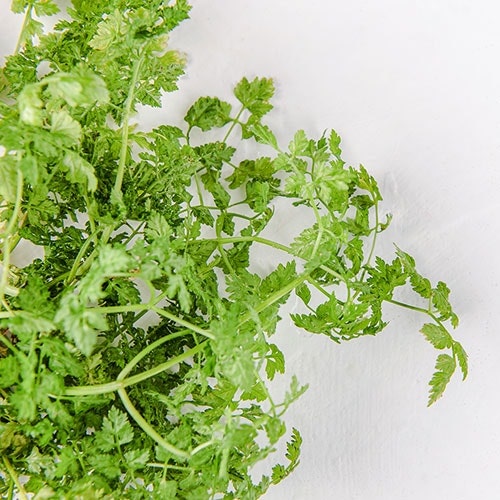Cookies help us deliver the best experience on our website. By clicking Accept you are agreeing to the placement and use of cookies as described in our privacy policy.
Chervil
DAYS TO SPROUT
DAYS TO
SPROUT
10-14 days
MATURES IN
MATURES
IN
60-70 days
TASTE IT FOR
TASTE IT
FOR
4-5 weeks
Plant Portfolio
Care & Harvest

🌱 Germination: Germination and true leaf growth can be slow. If your yCube has sprouted but true leaves have not formed, or if it has sprouted but roots are not visible after 14 days since you first saw it sprout, add the yCube to your Gardyn with plant food in it to help kick start its next phase of growth!
💡Temperature: Prefers cooler temperatures (55-65°F) and can bolt quickly in warmer environments.
✂️ Pruning: Remove leaves with brown spots if they appear. Chervil has a long taproot, so check the roots twice monthly and trim any that are brown or extending past the yPod. Snip flowers as they appear to extend the plant’s life.
🔎 Plant Health: Thrips are a common pest, but you can use our prevention tricks to keep them at bay
🌿 Harvest: Harvesting frequently helps prolong the plant’s life. Chervil has the most flavor when the plant is young and before it flowers. Snip entire outer branches at the base, leaving ⅓ of the plant at a time to ensure continuous and bushiest growth. If the leaves turn brown or purple, it’s time to replace it!
Quick Facts
Native to the Mediterranean region, Chervil was once referred to as “Myrhis” for the similarity of its essential oil to the resinous substance of Myrrh. It has a long history in traditional medicine to treat inflammatory conditions, digestive disorders, high blood pressure, and even alleviate hiccups.
Chervil is a good source of antioxidants along with vitamins A and C, carotene, iron, magnesium, calcium, zinc, folate, phosphorus, and selenium. Its bright flavor is a cross between tarragon and parsley with subtle hints of licorice or anise.
Chervil is a staple in French cooking and is part of the aromatic blend “Les Fines Herbes”. It may also be included in the popular “Les Herbes de Provence” blend. Traditionally a springtime herb, Chervil is commonly paired with seafood and spring vegetables, though its versatility lends itself to eggs, potatoes, baked goods, and soft cheeses. Its flavor notes are lost during drying or prolonged heating, so it’s best to use it fresh or at the final stages of cooking.
Harvest to Plate Recipe
How To Cook Chervil
INGREDIENTS
- ¼ cup olive oil
- 2 tablespoons fresh lemon juice
- 2 tablespoons rice vinegar
- ¼ cup roughly chopped chervil
- 2 tablespoons minced shallots
- Kosher salt and freshly ground pepper to taste
INSTRUCTIONS
Combine the olive oil, lemon juice, rice vinegar, chervil, shallots, and salt and pepper in a small bowl or container. Stir or shake to blend well.
No products in the cart.

